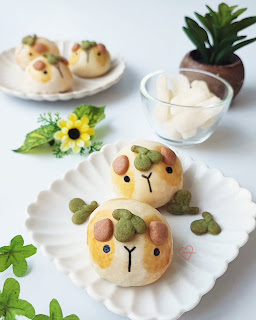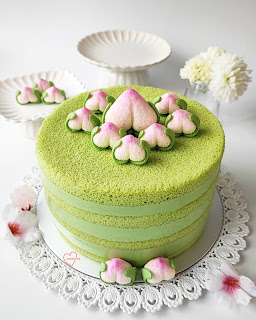I made this cake for a girl who loves food, bunnies, her Maltipoo pooch and chocolatey stuff with crunchy bits so I created this for her birthday!
I used my default Swiss meringue method recipe for this bake but I split this bake into three separate sessions and applied different variations of my Swiss method recipe to different batches. For the large green base, picnic basket and mini food items, I used all the egg whites in the Swiss meringue. For the bunny and dog, I split the egg whites into unwhipped to mix with dry ingredients to form a paste, and whipped in the Swiss meringue. I made extra pieces in case of accidental uglification.
I used edible markers and royal icing to add in the details. The sprinkles on cupcakes and donuts were added after the macaron batter was piped but before baking.
The picnic mat was made from leftover homemade fondant that I froze from an earlier project.
The fondant is glued onto the macaron shell with a little brush of water
The following are recipes for the individual components for this bake.
Chocolate feuilletine crunch
I made chocolate feuilletine crunch to add the chocolatey crunch goodness that the birthday girl likes. You may make the feuilletine from scratch but because I had so many components to make for this bake, I bought mine from Redman in Singapore. I melted a mix of milk and dark chocolate and mixed it with the feuilletine in the ratio of 1:3 for feuilletine:chocolate by weight. The fat from chocolate coats the feuilletine flakes and prevents them from turning soggy when sandwiched between ganache in the macarons or diplomat cream in the cake. Simply spread the mixture of melted chocolate and feuilletine in a thin layer on baking tray lined with parchment paper and freeze it until it is time to assemble.
I used 70g feuilletine and 210g chocolate to spread into a 10 x 12" tray
Dark chocolate ganache
I made the chocolate ganache slightly differently from my usual by adding a little corn syrup and gelatin.
150g Dark chocolate couverture
60g Heavy cream
6g Light corn syrup (optional)
12g unsalted butter, softened
1 gelatin sheet bloomed in ice water (optional)
Pinches of salt
1/2 tsp vanilla extract
1/2 tsp Kahlua coffee liqueur
Steps:
1. Heat chocolate in microwave/double-boiler until softened and slightly melted. Set aside.
2. Heat cream, salt and light corn syrup in small saucepan until it just starts to bubble at the edges. Pour over softened chocolate and let it sit for a minute.
3. Stir the chocolate in one direction until melted.
4. Melt bloomed gelatin after squeezing out excess water. Add to ganache and stir gently until well combined.
5. Add softened butter, vanilla and coffee liqueur. Mix well. Cover with cling wrap.
6. Set aside to firm up at cool air-conditioned temperature or in the fridge until toothpaste consistency.
7. Transfer into piping bag and fill the macarons. I didn't whip the ganache this time like I usually do for a lighter texture.
Mixed berry jam
I used frozen strawberries and freeze-dried raspberry powder as I couldn't get hold of fresh/frozen raspberries. You may use any mix or either type of berries for the jam. I tend to use only a little sugar and no pectin, to keep the berry flavours strong and without "fillers". I take my time to reduce the jam over low heat (about 30 minutes or more) until it is thickened to jam consistency. The sugar I use is 10% of the original weight of fruit.
400g strawberries
40g sugar
5g freeze-dried raspberry powder (you may add more if you wish)
Pinches of salt
I cooked until thickened and fruit is reduced to about 60% of its original weight. But for the macaron filling portion, I reduced the jam further to reduce the amount of water content even more.
Chocolate chiffon sponge
I used the default chocolate cake recipe from my ultimate chocolate cake, which was adapted from Rose Levy Beranbaum's German chocolate cake recipe. I whipped the egg whites portion like the meringue for chiffon cakes although Mdm Rose's recipe doesn't whip up the egg whites. Instead of steam baking, I tried baking at a lower temperature of 120C with the oven fan on for about 50min, and then increasing the temperature to 160C for 8min. The resulting cake was still moist and fluffy with flat tops. I sliced each sponge horizontally into half.
Chocolate diplomat cream
This recipe is similar to my default chocolate diplomat cream but I changed the ingredient amounts a little for some of the ingredients and changed the process of cooking a little.
220g + 30g milk
35g sugar
2 egg yolks
18g cornflour
12g cocoa powder
1/2 tsp vanilla extract
1/2 tsp Kahlua coffee liqueur
1/8 tsp salt
15g unsalted butter
40g dark chocolate couverture
100g whipping cream* (I used 15g dairy + 85g non-dairy)
* you may use full dairy, full non-dairy or a mix like I did in whatever ratios you like depending on climate and your taste preference. It is awfully hot in Singapore nowadays so I limit the amount of dairy cream.
Steps:
1. Heat 220g milk until steaming hot but not boiling. I just put my hand over the saucepan and once I can feel the heat and see steam rising from the milk.
2. In the meantime, whisk egg yolks, sugar, salt, cornflour, cocoa powder and 30g milk together in a heatproof jug.
3. Once the milk is hot, pour in a thin stream into the egg yolk mixture while whisking continuously. Pour everything back into saucepan.
4. Whisk the custard over medium-low heat until it starts to thicken. Remove from heat and continue whisking until smooth. Put it back on heat and continue whisking and cooking. Once it starts to bubble, continue whisking over heat for 1 minute before removing from heat.
5. Add chocolate couverture and butter. Whisk until smooth. Add extracts and mix well.
6. Transfer pastry cream into bowl and press cling wrap on surface. Refrigerate overnight or at least 2h.
7. When ready to assemble cake, whip whipping cream of choice until firm peaks. Briefly whip the chocolate pastry cream until loosened. Fold whipped cream into pastry cream in a few additions. Transfer into a large piping bag.
Macaron Assembly
I filled the large green macaron with dark chocolate ganache, followed by a disc of chocolate feuilletine crunch, some more ganache and mixed berry jam.
The dog, bunny and basket are filled with chocolate ganache and chocolate crunch. The mini food items are filled with just the ganache as they are really tiny.
The macarons were glued on with more royal icing onto the picnic mat
Cake Assembly
The cake is made of four layers of chocolate sponge with three layers of filling. The filling consists of chocolate diplomat cream, mixed berry jam, crunchy chocolate balls and chocolate feuilletine crunch. I brushed the sponge with some syrup (1:2 sugar:water) before layering on the filling as shown in the picture below.
From top left to bottom right:
1. Place chiffon sponge in acetate sheet ring. Brush the surface with some syrup.
2. Spread a thin layer of diplomat cream in the middle.
3. Pipe a ring of diplomat cream to the desired height you want.
4. Place chocolate feuilletine crunch in the middle.
5. Place a ring of crunchy chocolate balls around the chocolate feuilletine crunch. Add more diplomat cream if necessary.
6. Cover the crunch layer with a little diplomat cream.
7. Add a layer of berry jam.
8. Add a little diplomat cream over jam layer.
Repeat all steps until last top sponge is in place. Brush the surface with more syrup. Cover the top of the acetate ring with cling wrap before freezing for 2-3 hours. Carefully remove the acetate sheet.
I added more crunch around the base and on top of the cake, as well as more crunchy chocolate balls on the top.
As the sponge is soft and the macaron topper is heavy, I added 6 skewers in the cake as dowels under the crunch layer on top.
Here's a reel for this bake! I didn't document the whole process in detail because I didn't want the fuss of having to edit a tonne of content or have the joy of being in the moment of the bake the whole time.
https://www.instagram.com/reel/Czle4FLSjGL/?igshid=dzllM2lwcGNiYWpr
Thank God the cake was very well received! Here's a lovely picture of the birthday girl and her family along with the cake! I have permission from my client to share this picture.
with love,
Phay Shing

































